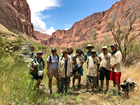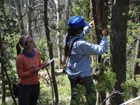Integrating Research and Resource Management in Intermountain National Parks
-
Glen Canyon National Recreation Area
Article 1: The Dragonfly Mercury Project: Citizen Science in Action at Glen Canyon National Recreation Area

This study, jointly managed by the National Park Service and U.S. Geological Survey, engages citizen scientists in collecting dragonfly larvae in national parks for mercury analysis. The results help inform resource management decisions and show that mercury concentrations vary widely both within and among parks, suggesting that they depend not only on source emissions, but also on landscape processes that occur after deposition. Read more
-
Petrified Forest National Park
Article 2: New Fossils Clarify the Early Evolution of Modern Frogs in North America

The fossil record of early frogs is very incomplete, especially in North America. A new fossil frog was discovered in the Late Triassic Chinle Formation (~220 million years ago) at Petrified Forest National Park that pushes back the earliest occurrence of frogs in North America by nearly 20 million years. This research is a collaboration between NPS and Virginia Tech paleontologists that continues to search for microfossils of early vertebrate groups. Read more
-
Yellowstone National Park
Article 3: Yellowstone National Park & United States Naval Academy Partnership: Student Designs for Improved Shoreline Access at Lake Yellowstone Hotel

Coastlines are dynamic and processes such as erosion and accretion challenge coastal managers and nearby infrastructure. A unique partnership between the NPS and the US Naval Academy has been established to tackle these concerns while providing valuable experience to students. Park staff and students work collaboratively to developed conceptual engineering designs that address vulnerable shoreline assets. Read more
-
Yellowstone National Park
Article 4: Collaborative Vital Signs Monitoring in Yellowstone National Park
Central to understanding and promoting the health of national parks is the availability of regularly-collected, high quality, long-term ecological information on key natural resource indicators of park health that the National Park Service refers to as “vital signs”. Examples of vital signs include water quality, plant communities, and amphibians. Read more
-
Article 5: Finding the Horse Creek Treaty of 1851 Site: An Interdisciplinary Approach to National Historic Landmark Designation

The National Park Service and its partners are undertaking an interdisciplinary approach to researching the National Historic Landmark eligibility of the 1851 Horse Creek Treaty site. The Horse Creek Treaty is nationally significant for its role in shaping the political landscape and westward migration into American Indian homelands. Read more
-
Tuzigoot National Monument
Article 6: Surveying for Northern Mexican Gartersnakes (Thamnophis eques megalops) at Tuzigoot National Monument

A variety of methods exist for surveying snake species. We used two of these methods in 2016 and 2017 to capture northern Mexican gartersnakes (Thamnophis eques megalops) in Tavasci Marsh at Tuzigoot National Monument in central Arizona. This species was listed as federally threatened in 2014 and faces population declines, mainly due to habitat loss. Read more
-
Article 7: Responding to Climate Change in the Southeast Utah Parks

This paper describes how the Southeast Utah Group of parks is responding to climate change. The paper summarizes expected future climate conditions compared with a 20th Century baseline. It describes the foundation of our work within the Climate Smart Conservation framework adopted at our initial workshop in December 2018. Read more
-
Glen Canyon National Recreation Area
Article 8: Citizen-based Acoustic Bat Monitoring Along the Colorado and San Juan Rivers

The rise of urgent environmental issues in National Parks has led resource managers to pursue citizen-based research projects to aid in the collection of scientific data. Glen Canyon National Recreation Area partnered with Grand Canyon Youth river guides and other organizations to collect data on the distribution of bat species within the park while simultaneously engaging youth and young adults in resource stewardship, citizen science, and service-learning. Read more
-
Article 9: The Intersecting Crossroads of Paleontology and Archeology: When are Fossils Considered Artifacts?

Understanding human knowledge and attitudes (human dimensions) towards paleontological resources through the cooccurrence of fossils and artifacts and/or tribal consultation (archeological context) helps us better appreciate those human values, perspectives, and beliefs. This understanding is important to the management, protection, and interpretation of these non-renewable resources. Read more
-
Saguaro National Park
Article 10: Climate Change and Other Factors Influencing the Saguaro Cactus

This article describes factors influencing the long-term dynamics of the saguaro cacti, a symbol of the desert southwest and namesake of Saguaro National Park. After decades of decline in some areas of the park, the saguaro population grew dramatically in the 1970s and 1980s, but establishment has been poor since then. We examine the influence of climate, tree-cutting, and other factors on changes in saguaro populations at the park. Read more
-
Casa Grande Ruins National Monument
Article 11: A New Way of Documenting and Imaging Cultural Resources

In 2018, Casa Grande Ruins National Monument received a grant from the Western National Parks Association to better document its cultural resources. This grant included funding for a small project that involved conservation and cleaning of the interior walls of the Great House, a 14th century Hohokam multi-story earthen structure that is the centerpiece of the park, followed by reflectance transformation imaging (RTI) photography.? Read more
-
Article 12: A Low-cost Air Quality Sensor for Measuring Particulate Matter

This article describes the results of a field evaluation of a low-cost air quality monitor called the PurpleAir, which measures the concentrations of particulates in the atmosphere. Data collected by a PurpleAir are compared to data from a colocated monitor that is used to determine whether particulate concentrations meet health standards. Read more

